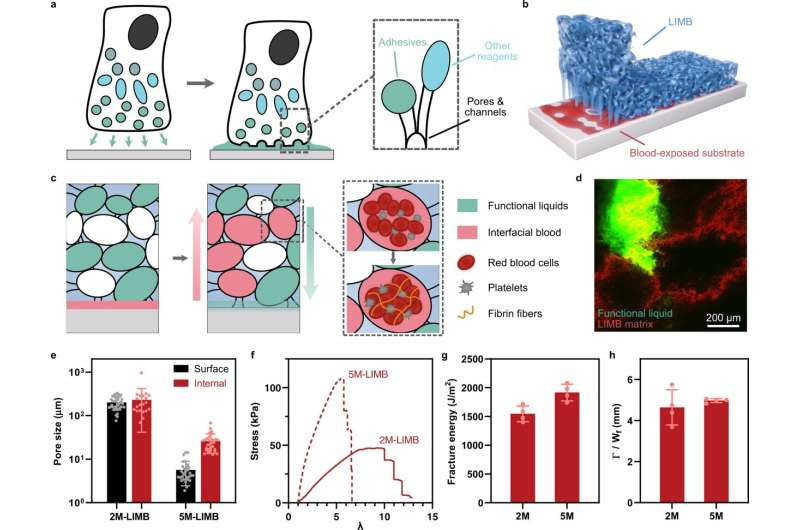by McGill University

Design of LIMB. a) Schematic illustration of marine organisms that contain interconnected micropores for adhesiveness and transport of liquid reagents. b) Schematic of LIMB adhering on blood-exposed substrates. c) Schematics showing that LIMB can uptake interfacial fluid, secrete functional liquids, and coagulate blood, thereby providing adhesion, hemostatic, and sealing function. d) Confocal image of rhodamine-labeled LIMB (red) containing micropores, partially filled with a FITC-labeled chitosan functional liquid (green). e) Sizes of surface and internal pores in LIMB containing 2 M or 5 M PAAm. f–h) Stress-stretch curves (f), fracture energy (g), and fractocohesive lengths (h) of LIMBs with varying PAAm content. Values in e, g, h represent the mean ± s.d. (n = 40 for 2M-LIMB Surface; 20 for 2M-LIMB Internal; and 30 for 5M-LIMB Surface and Internal in e; n = 4 in g, h; The experiment was repeated three times independently with similar results for d). Credit: Nature Communications (2022). DOI: 10.1038/s41467-022-32803-1
Every year around 2 million people die worldwide from hemorrhaging or blood loss. Uncontrolled hemorrhaging accounts for more than 30% of trauma deaths. To stop the bleeding, doctors often apply pressure to the wound and seal the site with medical glue. But what happens when applying pressure is difficult or could make things worse? Or the surface of the wound is too bloody for glue?
Drawing inspiration from nature, researchers from McGill University have developed a medical adhesive that could save lives, modeled after structures found in marine animals like mussels and flatworms. Their research is published in Nature Communications.
“When applied to the bleeding site, the new adhesive uses suction to absorb blood, clear the surface for adhesion, and bond to the tissue providing a physical seal. The entire application process is quick and pressure-free, which is suitable for non-compressible hemorrhage situations, which are often life-threatening,” says lead author Guangyu Bao, a recently graduated Ph.D. student under the supervision of Professor Jianyu Li of Department of Mechanical Engineering.
In putting the new technology to the test, the researchers found that the adhesive promotes blood coagulation. The adhesive can also be removed without causing re-bleeding, or can even be left inside the body to be absorbed. “Our material showed much better-improved safety and bleeding control efficiency than other commercial products. Beyond bleeding control, our material could one day replace wound sutures or deliver drugs to provide therapeutic effects,” says senior author Professor Jianyu Li.

Leave a Reply